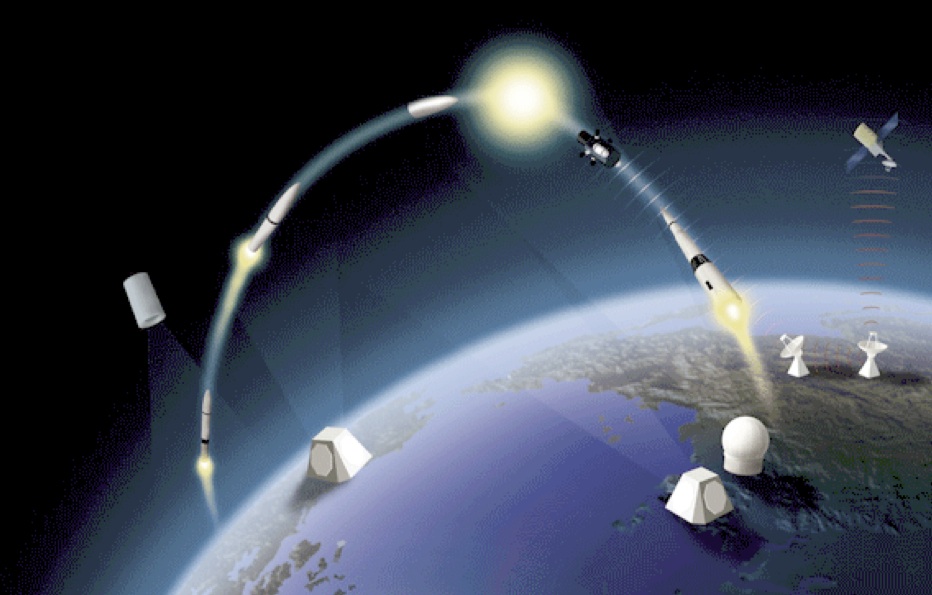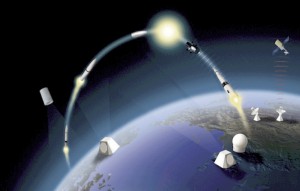The long thirty one year debate over missile defenses for the United States begun with the President Reagan announcement of the strategic defense initiative in March 1983 has now reached a critical stage.
The initial building of defenses in 2002 with the US withdrawal from the ABM Treaty has now reached where in the US arsenal there are over 1200+ interceptors of all kinds that can deal with short, medium and long range rockets aimed at the United States and its allies.
The struggle now is to determine how many such interceptors should the US aim to build into the future; what kind of interceptors and associated radars and sensors are best for our security; and at what pace and speed should such deployments be undertaken including modernizing, expanding and replacing those defense missiles we now have.
These are not trivial concerns.
Reports from the Middle East are that ISIS, the terrorist group occupying portions of both Syria and Iraq, has paraded a Scud missile, probably with a range of upwards of 300 kilometers.
More worrisome have been parallel reports that areas controlled by ISIS in Syria are also knows areas where chemical weapons shells have gone missing.
At the other end of the spectrum, the North Koreans—now understood to be the missile builders for Iran—launched a space launch vehicle in a southerly direction that managed to orbit an object over the United States.
And both China and Russia continue to turn out sea and land based systems that will soon reach many hundreds of new rockets.
Critics of missile defense say we should go slow. They assert North Korea and Iran have not yet tested missiles of sufficient range to reach New York or Washington or Los Angeles. And so we are assured we have plenty of time to build defenses if such threats materialize.
Like defending civil aviation only after the threat is obvious. Or defending against EMP after the grid has been taken down.
Critics also assert that even should such threats arise, no leader in Pyongyang or Tehran will launch a strike against an American city because seeing where the rocket originates, we would return fire, missile for missile, and obliterate the offending state entity.
Deterrence, it is asserted, especially our nuclear deterrent, is sufficient for now to deter the Kim dynasty in North Korea or the mullahs and Supreme Leader in Iran.
But if the US deterrent capability—some 1550 countable deployed strategic nuclear warheads– is in the eyes of these leaders sufficient to NOW deter their use of ballistic missiles against the United States, why are they building such arsenals of ballistic missiles of increasing range and why are they developing nuclear weapons—confirmed by North Korea and alleged with respect to Iran—to place on such missiles?
Here the critics of missile defense have to engage in some sleight of hand.
The folks in Tehran and Pyongyang are deterring the US, not the other way around. They worry we—the United States– will attack them. And not being able to match our conventional capability, the theory goes, they have developed nuclear weapons—or are developing in the case of Iran—to offset such US capability.
In short, as critics argue, Iran and North Korea are deterring the US and thus the US missile defenses appear to both countries as part of an elaborate plot to develop the capability to strike at both countries with impunity as our missile defenses makes us immune from retaliatory attack.
What’s wrong with this picture?
Everything.
North Korea and Iran have been actively at war with the United States and its allies since 1953 and 1979 respectively. We are protecting both our homeland and our allies from the aggression of Tehran and North Korea.
There are some 200 countries in the world—why are North Korea and Iran deemed rightfully able to build nuclear weapons outside the requirements of the Nuclear Non-Proliferation treaty which they voluntarily signed onto which prohibits them from doing so? When everyone else obeys the rules?
In short, the missile defense critics have to turn the world upside down and make the US into the aggressor.
Now the US liberation of Iraq and Afghanistan supposedly gives some credence to this view. Iran and North are next, right?
Hardly.
Let’s examine the facts.
First, Afghanistan’s Taliban had to be taken down as co-perpetrators of 9-11.
Second, the Iraq Liberation Act of 1998 was standing US policy that grew out of Saddam’s invasion of Kuwait in 1990, his support of terrorism including providing safe harbor for two of the terror master minds of the February 1993 World Trade Center bombing, and his history of WMD development and use.
Also Iran and North Korea began their nuclear weapons programs roughly at the same time– in 1988-89—long before 9-11 and the subsequent conflicts in Afghanistan and Iraq. And both were state sponsors of terror against the US which is the predicate to US involvement with both states.
Missile defense thus must be examined beyond the simple idea that these two rogue states are really simply defending themselves. They have been and are at war with the United States and ballistic missile developments are a key factor in that effort.
Let’s examine this more thoroughly.
It is assumed a small nuclear arsenal deployed by North Korea is a reasonable reaction to a possible US invasion. But would a DPRK nuclear arsenal of 6-12 weapons really stop the US from invading North Korea and would their absence give the US a green light?
In the nearly half a century since the Korean War when Pyongyang had no nuclear weapons, when did the US ever use military force against North Korea—we did not after the USS Pueblo was captured and her crew tortured, not after American soldiers were murdered in the DMZ and not after a civilian airliner was blown up in the Gulf of Siam.
So too with Iran. Tehran is directly and explicitly connected to the terror attacks at the Marine Barracks in Lebanon, Lockerbie, Khobar Towers, the African embassies, and 9-11. In short, Iran has been complicit in the death of thousands of Americans.
Iran is defending itself from what, again?
When has the US used military force against Iran despite thousands of Americans having been murdered by Tehran’s rulers?
Once, when President Ronald Reagan reflagged the Kuwait oil tankers and stopped Iranian attacks on Gulf shipping. Period.
So let’s start with the right basis for looking at this issue.
If deterrence including nuclear deterrence is all that the US needs to deter Iran and North Korea, why do they continue to attack the US and its allies, commit widespread terrorism against the US and its allies, and seek both ballistic missiles and nuclear weapons?
What if such weapons are for blackmail, coercion and terror? And in fact the threatened use of such missiles is sufficient for their objectives providing top cover for covert terrorism?
Sure we know where their missiles will be launched from, but only if they are launched from a readily discoverable base. What if launched from the ocean from a freighter in an EMP mode?
North Korea threatens to launch missiles or explode nuclear devices. It then promises to desist for a price. If paid sufficiently in oil or rice. Protection money it’s called. And billions have been paid to Pyongyang since 1994.
Iran uses its missiles as top cover to extend its terrorist ways throughout the Middle East, not the least of which has been their killing of hundreds of Americans in Afghanistan and Iraq since 2002.
Missiles thus serve Iran and North Korea without ever having to be launched.
Missile defenses for the US and its allies could render this blackmail inoperable. Missile defenses would give diplomatic weight to a US and allied refusal to be blackmailed or coerced by Iran or North Korea.
Iran also uses missiles as terror threats through its solely owned subsidiaries Hamas and Hezbollah. It routinely threatens to launch rockets against US allies and assets in the Gulf.
Iran obviously remains undeterred to carry out its terrorist activities. Thus is it not obvious that its offensive missile capability especially if mated with nuclear weapons—would give it an increasing hegemonic role in the Persian Gulf and beyond.
We are seeing the diplomatic and military benefits of missile defense with the current situation in Israel. Missile defense allows Israel (and its allies including the US) the opportunity to engage in a measured response to the rockets being fired at Israeli cities. From midnight on Tuesday morning to noon the next day—12 hours—130 rockets were fired from Gaza onto Israel.
Lives can be saved. Targets can be better selected. Diplomacy can also be allowed to work. There is no guarantee of course that everything remains under control as we are witnessing in Israel. But missile defense gives us options.
More importantly, a missile defense of the United States capable of shooting down dozens of missiles can keep crises or conflicts from escalating.
Similarly a missile defense system consisting of 3-4 sites and 100+ interceptors in the US could be very effective against limited strikes and thus also prevent a crisis or conflict from escalating to the use of nuclear weapons.
For example, even if unable to stop 100-200 warheads aimed at the United States, missile defenses proposed here—space, land or sea-based– can stop such attacks below that number especially threats of blackmail or coercion.
To be effective–in the face of solid American and allied missile defenses (here Canada should be taken up on its exploration of joining a US defense system)– a threatened nuclear attack by an adversary would have to involve a fairly sizeable number of warheads, raising the specter of triggering Armageddon.
That has always been a part of US policy even throughout the Cold War.
In short, force an adversary to have to risk everything or as an alternative leave the nuclear weapons at home.
Just as in a crisis we can put more submarines to sea, place our bombers on strip alert and make our ICBMs mobile, missile defenses raise the bar to the use of such weapons.
Given the limited arsenal of North Korea and the prospects of such an arsenal being developed by Iran, US and allied missile defenses must be deployed in a timely fashion in anticipation of such expanding threats.
Having such a capable and effective defense also simultaneously can deter the threatened use of nuclear weapons by other adversaries, whether in Europe, the Asian Pacific or the Persian Gulf, by having the ability from a multitude of areas to be able to shoot down the bad guy’s missiles.
That is genuine deterrence.
And it puts back into perspective why diplomacy is improved markedly with the deployment of American missile defenses.
. . . . . . . . . . . . . . . .
Peter Huessy is Senior Fellow in National Security Affairs at the American Foreign Policy Council in Washington, DC. This was originally published as an essay for Frontiers of Freedom July 10th, 2014.

